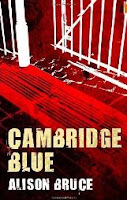I know a lot of people participated in the Mistborn trilogy read-along, but I quickly skimmed through those posts because I thought I might want to read the series and didn't want to know too much. The library didn't have the books, but they did have
The Alloy of Law, a Mistborn novel, but one that is not part of the original trilogy.
The Alloy of Law is set in a different time period, centuries in the future of Scadrial, and it is a stand-alone novel that doesn't require one to have read the earlier series.
The cover is very steampunk, and the content follows in this vein as well. It opens in the
Roughs, the equivalent of the Wild West. Waxillium Ladrian is a law man in this wide-open country, taking care of the bad guys and keeping order in the turbulent and relatively untamed hinterland--until two events cause him to abandon his role and return to the city where he must reluctantly change his role from free-for-all law man to head of the House of Ladrian.
I wasn't much taken with the magic of allomancy and feruchemy which seemed contrived and self-conscious--as if trying to find a new way to present magic was the main intention. The villains were certainly bad guys, but they were pretty much cardboard figures to promote or explain the action.
Words have great power of connotation (home, hearth, apple pie), and it is always fun to see authors give power to the word itself and not just to the content of the sentence. Dickens was a master of this, and the example that comes to mind is the use of "brass" in
Hard Times. He used the word in so many ways: the metal itself (brass door knocker), authority (top brass), counterfeit (as in coin), brazeness (brassy), audacity, arrogance, etc.
All that to explain the unpleasant connotation I felt (for some unknown reason) to the name Waxillium. When the author referred to him as Wax, I was fine, but each time he used Waxillium, my skin crawled.
The novel felt like it tried too hard, and I think I'd have liked it better without the over-the-top incidents, but there were some things that worked for me.
Wax was a likable character, with potential to gain substance if there is a sequel. My favorite character, however, was Wayne, the sidekick. Wayne was funny, charming and pretty much a chameleon, changing his accent and persona with ease. Marasi, the female protagonist, was good with a rifle, but for some reason in spite of a large role, she never felt solid. On the other hand, Steris, the woman whom Wax is to marry (he for money, she for status), played only a very small role, but has inherent possibilities.
If there is a sequel, I would read it just to see if Sanderson does something interesting with Steris.
I'll give Sanderson another try and see how it goes.
Fiction. SF/Fantasy. 2011. 336 pages. library book.













